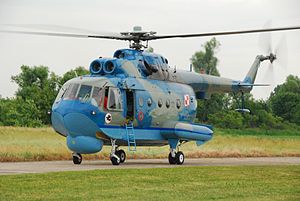Mil Mi-14
| Mi-14 | |
|---|---|
 |
|
| Polish Navy Mil Mi-14PL in 2011 | |
| Role | Anti-submarine helicopter |
| Manufacturer | Mil Moscow Helicopter Plant |
| First flight | September 1969 |
| Introduction | 1975 |
| Retired | still in service as of January 1, 2016 |
| Status | Active service; out of production |
| Primary users |
Soviet Naval Aviation Russian Naval Aviation Libyan Air Force |
| Produced | 1974-1986 |
| Number built | 230 |
| Developed from | Mil Mi-8 |
The Mil Mi-14 (Russian: Миль Ми-14, NATO reporting name: Haze) is a Soviet shore-based nuclear-capable amphibious anti-submarine helicopter derived from the earlier Mi-8.
Formal development of an anti-submarine warfare (ASW) version of the Mil Mi-8 transport helicopter was authorised by the Soviet Communist Party Central Committee and Council of Ministers in April 1965, with the objective of replacing the Mil Mi-4 in the short-range, shore based anti-submarine role. The new helicopter was required to have an endurance of 2 hours on station at a radius of 222 kilometres (120 nmi; 138 mi) from base.
The new design (with the internal designation V-14) differed from the Mi-8 in having a boat-like hull similar to the Sea King, allowing it to operate off the water, and a retractable four-point undercarriage, with the mainwheels retracting into large sponsons on the rear of the fuselage. The helicopter was to be powered by two Klimov TV3-117MT turboshaft engines. A watertight weapons bay is fitted to the centreline of the fuselage allowing internal carriage of a single torpedo or eight depth charges, while a radome housing a search radar is fitted beneath the nose.
The first prototype V-14, converted from a Mi-8 and powered by the older and less powerful Klimov TV2-117 engines, flew on 1 August 1967. Development was slowed by problems with the helicopter's avionics and due to reliability problems with the TV3-117 engines, with production at Kazan not starting until 1973, and the helicopter (now designated Mi-14) entering service on 11 May 1976.
Allegedly due to the strong pressure from the United States, all Russian antisubmarine Mi-14 helicopters were decommissioned in 1996. In May 2015, RT has reported that Mi-14 is being highly sought after by the Russian Black Sea and the Northern Fleets, and that Kazan Helicopter Works (KVZ) is preparing to return 10 previously decommissioned helicopters to active Russian Navy service with the production of new units beginning within five years. The initial demand was estimated at 100 helicopters.
...
Wikipedia
